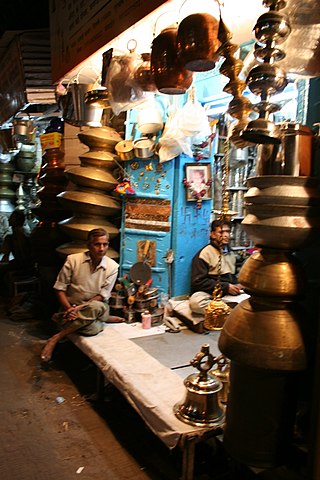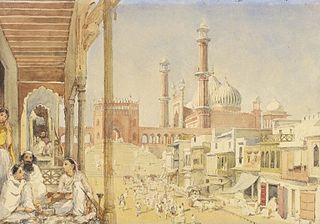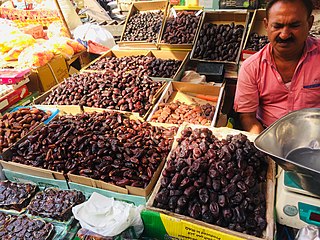
Delhi has been, since historical times, a favoured destination for shoppers.
The Chandni Chowk is one of the oldest and busiest markets in Old Delhi, India. It is located close to the Old Delhi Railway Station. The Red Fort monument is located at the eastern end of Chandni Chowk. It was built in the 17th century by the Mughal Emperor, Shah Jahan, and designed by his daughter, Jahanara. The market was once divided by canals to reflect moonlight. It remains one of India's largest wholesale markets.

Paharganj is a neighbourhood of Central Delhi, located just west of the New Delhi Railway Station. Known as Shahganj or King's ganj or market place during Mughal era, it is one of the three administrative subdivisions, of the Central Delhi district, of the National Capital Territory of Delhi, with the other two being, Darya Ganj and Karol Bagh.

Old Delhi is an area in the Central Delhi district of Delhi, India. It was founded as a walled city named Shahjahanabad in 1648, when Shah Jahan decided to shift the Mughal capital from Agra. The construction of the city was completed in 1648, and it remained the capital of Mughal India until its fall in 1857, when the British Empire took over as paramount power in the Indian subcontinent.

Daryaganj is a neighbourhood of Delhi inside the walled city of Old Delhi. The "darya" refers to the river Yamuna which was just outside the walled city. Daryaganj is one of the three sub-divisions and also the administrative headquarters of the Central Delhi District. It starts at Delhi Gate, at the edge of Netaji Subhash Road, which goes towards Red Fort.
For other places with the same name, see Wazirabad (disambiguation)

Chawri Bazar is a specialized wholesale market of brass, copper and paper products. Established in 1840, with a hardware market, it was the first wholesale market of Old Delhi it lies to the west of Jama Masjid in Delhi.

The Urdu Bazaar is a major market in the walled city of Delhi, India that connected the canal in the middle of Chandni Chowk to Jama Masjid. The original market was destroyed in the aftermath of Indian Rebellion of 1857, but its name survives as a location near the Jama Masjid.

Khari Baoli is a street in Delhi, India known for its wholesale grocery and Asia's largest wholesale spice market selling a variety of spices, nuts, herbs and food products like rice and tea. Operating since the 17th century, the market is situated near the historic Delhi Red Fort, on the Khari Baoli Road adjacent to Fatehpuri Masjid at the western end of the Chandni Chowk, and over the years has remained a tourist attraction, especially those in the heritage circuit of Old Delhi.
Delhi City Lok Sabha constituency was a Lok Sabha (parliamentary) constituency in Delhi from 1951 to 1956. This constituency comprised the entire Kashmere Gate, Kotwali and Hauz Qazi police stations and part of Faiz Bazar police station of Delhi, which was a Part C state from 1950 to 1956.
Model Town Assembly constituency is one of the seventy Delhi assembly constituencies of Delhi in northern India. Model Town assembly constituency is a part of Chandni Chowk . Model town is one of the posh areas in the North Delhi region. It is divided into parts viz. Model town 1 Model town 2 & Model town 3.
Sadar Bazar Assembly constituency is one of the seventy Delhi assembly constituencies of Delhi in northern India. Sadar Bazar assembly constituency is a part of Chandni Chowk.
Matia Mahal Assembly constituency is one of the seventy Delhi assembly constituencies of Delhi in northern India. Matia Mahal assembly constituency is a part of Chandni Chowk.
Sadar Bazaar may refer to:

Shastri Nagar is a mixed-use locality in North West Delhi district in City - S P Zone under the Jurisdiction of NDMC in the National Capital Territory of Delhi. Shastri Nagar is one of the Category E residential colonies in Delhi. Shastri Nagar is part of the Sadar Bazar assembly constituency and Chandni Chowk parliamentary constituency.

Chandni Chowk is a neighbourhood of North Kolkata in Kolkata district in the Indian state of West Bengal. It is famous for its old and cheap market of computer software products and hardwares, and had been listed as a notorious market in 2009 and 2010 by the USTR for selling counterfeit software, media and goods.










